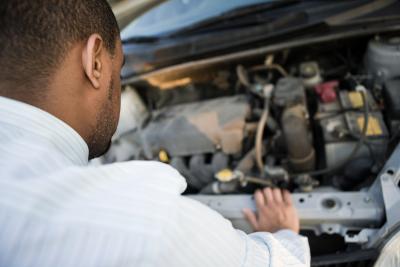
Build the most essential part of a hydrogen fuel system for an automobile, the hydrogen generator housing. Eliminate dependence on gasoline for fuel by powering your car with a water-fueled hydrogen generator system. The hydrogen generator is the heart of the system; build one out of high grade CPVC plastic and epoxy. Wire the hydrogen generator chamber with electrodes to separate water into oxygen and usable hydrogen gas.
Cut a generator housing out of a four inch-diameter CPVC pipe. The correct length will be between 10 and 18 inches, depending on the space in your engine compartment. Use a jig or table saw or a miter box to ensure a straight cut.
Cut two tubes out of thin gauge steel pipe to make the generator electrodes. One electrode must fit inside the other. The gap between the inner electrode diameter, and the outer electrode should be .3 inches. Cut the electrode tube length five inches shorter than that of the generator housing. Drill eight 1/4-inch holes around the perimeter of one end of the outer electrode tube. The holes should be 3/8 of an inch from the tube edge. After drilling debur the holes. Repeat the drilling process on the inner electrode tube.
Affix the base of each electrode tube to the inside of a four-inch CPVC end cap. Drill holes in the end cap, and run wires through to the electrodes. Solder the wiring to the steel tubes with silver flux solder. Seal the holes with high-quality epoxy once the wires have been run through.
Seal the end cap with the electrode tubes to the end of the generator housing with JB Weld or similar high-grade epoxy. Allow the epoxy to set for 24 hours. Drill a hole, one-half inch in diameter, an eighth of an inch above the rim of the sealed end cap. Connect a pipe to the hole with epoxy. The tube length should be approximately one inch. This water inlet will be connected to the water tank by an appropriate size hose.
Wrap fine-grade copper wire around a Ferrite Toroid Coil Core (National Magnetics Part # 995). Use at least 250 turns of wire. Mount the magnetic coil inside a second CPVC end cap.
Punch or drill three holes in the end cap containing the copper magnetic coil to install valves. Install a pressure-relief valve, a valve for feeding hydrogen to the carburetor and a valve for the pressure indicator inside the instrument panel. Seal the end cap to the top of the hydrogen generator housing with epoxy.
Mount the hydrogen generator inside the engine compartment of your vehicle. There are a variety of engine shapes and layouts, so use appropriate brackets or hardware to hold the generator housing based on the shape and layout of your vehicle. You are ready to connect the carburetor adapter hose to the top of the hydrogen generator housing, the electrode wires to the electronics system and the feed hose from the water tank. The hydrogen generator housing is complete.